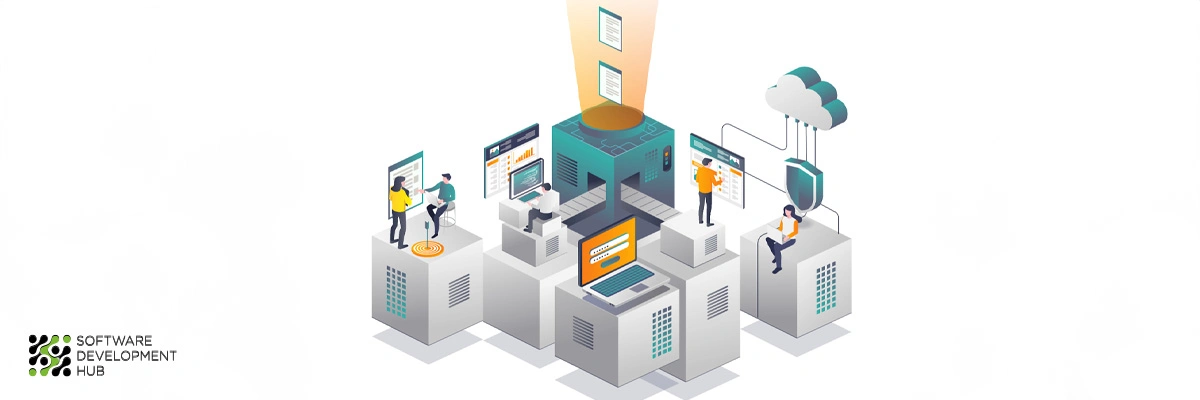Microservices Architecture and DevOps as a Service: A Perfect Match
Companies like Netflix and Amazon have achieved notable success by adopting microservices, gaining significant advantages in agility and efficiency within their software development processes. Their experiences highlight how microservices architecture is changing application development and deployment approaches across the industry.
When microservices architecture is combined with DevOps practices, organizations experience enhanced deployment capabilities and improved system reliability. Microservices allow development teams to operate independently on separate services, which boosts productivity and minimizes coordination overhead. This architectural choice also improves system stability—problems in one service typically don't cascade through the entire application.
We'll examine how microservices and DevOps work together, outline their primary benefits, and discuss practical implementation strategies. The article will also cover typical challenges teams face and provide tested solutions to help you get the most from this technical combination, including the implementation of CI/CD (Continuous Integration and Continuous Delivery) pipelines.
Understanding Microservices Architecture Benefits
Microservices architecture has become an effective approach for modern application development, providing notable flexibility and scalability when compared to traditional systems. Let's look at what makes this architecture valuable for organizations looking to enhance their software development processes.
What defines a microservices architecture
Microservices architecture is built around a collection of small, autonomous services working together to form a complete application. Each microservice is self-contained and implements a specific business function within a bounded context. Unlike monolithic applications, these services can be deployed independently, allowing teams to update individual components without rebuilding the entire system.
The main characteristics of microservices include:
- Independent operation: Each service runs in its own process and communicates through well-defined APIs
- Single responsibility: Services typically have a specific purpose and focused functionality
- Decentralized data management: Each service manages its own database, often using different database technologies
- Technology diversity: Services can be written in different programming languages based on requirements
Key advantages over monolithic systems
When compared to traditional monolithic architecture, microservices offer several benefits that directly impact development efficiency and system performance. Microservices provide better fault isolation—if one service fails, it won't affect the entire application, helping maintain system stability.
Applications based on microservices are easier to understand and maintain. Since services are small and focused, developers can quickly understand the codebase without navigating through complex, interconnected systems. This modularity also improves testability, as teams can validate individual services without complex integration testing.
Another important advantage is independent scalability. With microservices, teams can scale specific components based on demand rather than scaling the entire application. This targeted approach optimizes resource usage and cuts costs by eliminating unnecessary scaling.
How microservices enable business agility
One of the strongest reasons organizations adopt microservices is the business agility they provide. Microservices architecture shortens development cycles by enabling teams to work in parallel. Each team can take responsibility for specific services, developing and deploying them independently with minimal coordination.
This autonomy encourages innovation and experimentation. Teams can try new features or technologies with lower risk, as changes remain isolated to specific services. As a result, organizations can respond more quickly to market changes and customer needs.
Microservices support a product mentality rather than just project delivery. Teams maintain ownership of their services throughout the entire lifecycle, creating stronger connections between developers and the business value they deliver. This alignment between technical implementation and business capabilities keeps development efforts focused on delivering practical benefits to users and stakeholders.
Additionally, microservices architecture allows for incremental modernization. Instead of undertaking risky complete system rewrites, organizations can gradually replace components of legacy applications, reducing risk while steadily improving their technology landscape.
The Evolution of DevOps as a Service
DevOps practices have significantly changed software development over the past decade, yet many organizations face implementation challenges. According to Gartner, by 2023, DevOps as a Service will be used by 60% of Global 1000 organizations. This transition shows how companies are finding new ways to access and implement DevOps capabilities, including cloud-native DevOps solutions.
Traditional DevOps vs. DevOps as a Service
Traditional DevOps requires organizations to build internal expertise, infrastructure, and toolchains—often demanding substantial upfront investments in both technology and talent. Teams need to establish their own CI/CD pipelines, security protocols, and monitoring systems. This approach gives organizations complete control but typically leads to higher costs and slower implementation.
DevOps as a Service (DaaS), on the other hand, delivers DevOps practices through a cloud-based service model. Organizations gain access to ready-to-use tools, infrastructure, and expertise without building everything from scratch. DaaS breaks down silos between development and operations teams, improving communication and collaboration among stakeholders. It essentially implements DevOps culture within cloud services [2], offering a range of CI/CD tools and automation capabilities.
Core components of DevOps as a Service offerings
Most DaaS solutions include these essential components:
- Cloud Infrastructure: Elastic computing, storage, and networking resources that scale on demand
- Containerization and Orchestration: Tools like Docker and Kubernetes for application packaging and management
- CI/CD Pipelines: Automated processes for code integration, testing, and deployment
- Infrastructure as Code (IaC): Provisioning and managing resources through scripts rather than manual configuration
- Monitoring and Observability: Real-time tracking of application performance and system health
These components work together to enable faster and more reliable software delivery, which is particularly useful for microservices architectures that need frequent deployments. The CI/CD pipeline automation provided by DaaS solutions helps streamline the continuous integration and continuous delivery processes.
Why organizations are shifting to the as-a-service model
The DevOps as a Service market is projected to grow at a compound annual rate of over 25% from 2021 to 2023, driven by several key factors. DaaS reduces costs through more efficient resource usage and eliminates expensive infrastructure investments.
DaaS also speeds up time-to-market by offering immediate access to optimized toolchains. Organizations can start operations faster, reducing setup time from weeks to hours. Self-service capabilities allow developers to manage infrastructure without specialized DevOps engineers, giving teams more autonomy.
DaaS helps address the skills gap that often hinders DevOps adoption. According to secondary data, 84% of organizations face barriers to DevOps implementation, with workforce skill shortages being one of the biggest challenges. By using external expertise, companies can overcome these limitations while staying focused on their core business goals.
Creating the Perfect Integration Between Microservices and DevOps
The success of microservices implementation depends on effective DevOps integration, which establishes a framework that enhances deployment efficiency and system reliability. Achieving optimal integration requires several key components working together to deliver the full benefits of microservices, including robust CI/CD pipeline automation.
CI/CD pipelines for microservices deployment
Faster release cycles are a major advantage of microservices architectures, but without a robust CI/CD process, organizations cannot achieve the agility that microservices promise. Well-designed CI/CD pipelines allow each team to build and deploy services independently without affecting others. These pipelines also ensure that before deploying new service versions to production, they go through validation in development, testing, and QA environments with quality checks at each stage.
The CI/CD pipeline is crucial for implementing continuous integration and continuous delivery practices. It automates the build, test, and deployment processes, enabling teams to deliver code changes more frequently and reliably. The CI process involves automatically integrating code changes into a shared repository, while CD automates the delivery of applications to selected infrastructure environments.
Containerization and orchestration strategies
Containerization creates consistency and reliability across microservice environments. This approach makes deployment simpler and ensures services perform consistently across different environments through:
- Standardized build and deployment processes
- Complete dependency packaging
- Support for technology diversity across teams
Orchestration tools like Kubernetes automate the deployment, management, and scaling of containerized applications. They eliminate many manual processes involved in deploying and scaling microservices. These tools also support advanced deployment strategies such as:
- Rolling updates - deploying new instances gradually
- Blue-green deployments - deploying alongside previous versions
- Canary releases - rolling out to a small subset of users first
Container orchestration platforms like Kubernetes also provide container registry functionality, allowing teams to store and manage container images efficiently. This integration of container registry and orchestration capabilities streamlines the deployment process for microservices.
API management and service mesh implementation
API management offers centralized control over microservices interactions. It provides authentication, secure communication protocols, and rate limiting. A service mesh handles all communication between services in applications through containerized microservices. It removes the logic governing service-to-service communication from individual services and abstracts it to its own infrastructure layer.
Implementing a service mesh can significantly enhance security in microservices architectures. It provides features like mutual TLS (mTLS) for service-to-service authentication and encryption, as well as fine-grained access control policies. Additionally, service meshes often include built-in vulnerability scanning capabilities, helping teams identify and address security issues more effectively.
Automated testing frameworks for microservices
Thorough testing is vital for microservices architecture. Comprehensive approaches include integration testing to verify services work together properly, contract testing to confirm each service follows its defined contract, and end-to-end testing to check the entire functionality of the system. Tools like Parasoft SOAtest can create test clients that send request messages to microservices and verify responses.
Implementing test automation is crucial for maintaining the agility of microservices development. Continuous integration testing, or CI testing, ensures that code changes are validated quickly and consistently. This approach helps catch issues early in the development process, reducing the cost and effort of fixing bugs later in the lifecycle.
Implementing a Successful Microservices-DevOps Strategy
Moving to a microservices-DevOps paradigm requires careful planning, proper team structures, and well-thought-out migration approaches. Organizations that successfully implement these elements gain important advantages through better scalability, system resilience, and faster delivery. This section will explore key aspects of implementing a microservices-DevOps strategy, including the use of infrastructure-as-code and GitOps practices.
Assessment and planning phase
Before implementation, it's essential to understand your core business priorities. Document service level agreements (SLAs) that align with various application components to ensure commitment across the organization. Next, evaluate your current infrastructure's readiness, as inadequate infrastructure can result in poor performance even when following best practices. Review existing processes, tools, and technologies to identify potential obstacles or areas that need improvement.
During this phase, consider adopting infrastructure-as-code (IaC) practices. IaC allows teams to manage and provision infrastructure through code, enabling version control, automated deployment, and consistency across environments. This approach aligns well with microservices and DevOps principles, facilitating faster and more reliable infrastructure management.
Building the right team structure
Traditional team structures often don't work well with microservices implementation. Consider forming smaller teams (3-4 people) that focus on specific domain objects]. Cross-functional teams with both development and operations skills promote better collaboration and minimize handoffs. These teams should have autonomy while following shared governance principles that establish agreement on the broader microservices strategy.
Encourage teams to adopt GitOps practices, which use Git as a single source of truth for declarative infrastructure and applications. GitOps enhances collaboration, improves traceability, and streamlines the deployment process by automating infrastructure updates based on changes in the Git repository.
Migration strategies from monolith to microservices
Incremental migration works better than trying to refactor everything at once. The Strangler Fig pattern—gradually replacing parts of a monolithic application while it continues running—reduces risks during transition. Start by identifying loosely coupled modules as initial candidates, especially those with different resource requirements from the rest of the monolith. Throughout the migration process, establish communication between services and the monolith using well-defined API contracts.
As part of the migration strategy, consider implementing a cloud-native CI/CD pipeline. Tools like Jenkins, Red Hat OpenShift, or Tekton can help automate the build, test, and deployment processes for your microservices. These cloud-native CI/CD solutions are designed to work seamlessly with containerized applications and provide the flexibility needed for microservices architectures.
Common challenges and how to overcome them
Complexity remains the primary challenge in microservices implementation. Managing many independent services creates significant difficulties in communication, consistency, and dependencies. To address this, use automation tools such as deployment automation technologies and continuous integration frameworks. Security is another challenge due to the distributed nature of data. Implement identity and access management solutions along with service-to-service authentication protocols to maintain secure communication.
Monitoring becomes more difficult with multiple services potentially using different programming languages. Use comprehensive monitoring solutions that provide centralized logging and real-time feedback to quickly identify and fix issues. Additionally, consider implementing vulnerability scanning as part of your CI/CD pipeline to proactively identify and address security issues in your microservices.
When dealing with cloud-native applications, teams may face challenges related to managing stateful services and ensuring data consistency across microservices. Implementing patterns like event sourcing or using distributed databases can help address these issues. Additionally, adopting immutable containers can improve consistency and reliability in your microservices deployments.
Conclusion
Microservices architecture combined with DevOps as a Service gives organizations a practical path toward efficient, scalable, and resilient software development. Through independent service deployment and continuous delivery practices, teams achieve greater agility while maintaining system stability. DevOps as a Service removes traditional implementation barriers by providing ready-to-use tools and expertise without large upfront investments.
Success with this technical combination depends on thoughtful planning and execution. Organizations should begin with small steps, focusing on clearly defined services and gradually expanding their microservices footprint. Automated testing, well-designed CI/CD pipelines, and thorough monitoring help ensure reliable service delivery across the entire application.
While challenges exist—especially regarding complexity and security—tested solutions and best practices make these obstacles manageable. Teams that adopt cross-functional collaboration, implement appropriate tools, and follow step-by-step migration strategies set themselves up for long-term success.
As technology continues to advance, microservices and DevOps as a Service will remain key components of modern software development. Organizations that master this approach gain important competitive advantages through quicker delivery, improved scalability, and better system reliability. By leveraging cloud-native DevOps practices and tools like Red Hat OpenShift, Tekton, or Ansible Automation Platform, teams can further enhance their microservices implementations and streamline their development processes.
Categories
About the author
Share
Need a project estimate?
Drop us a line, and we provide you with a qualified consultation.








